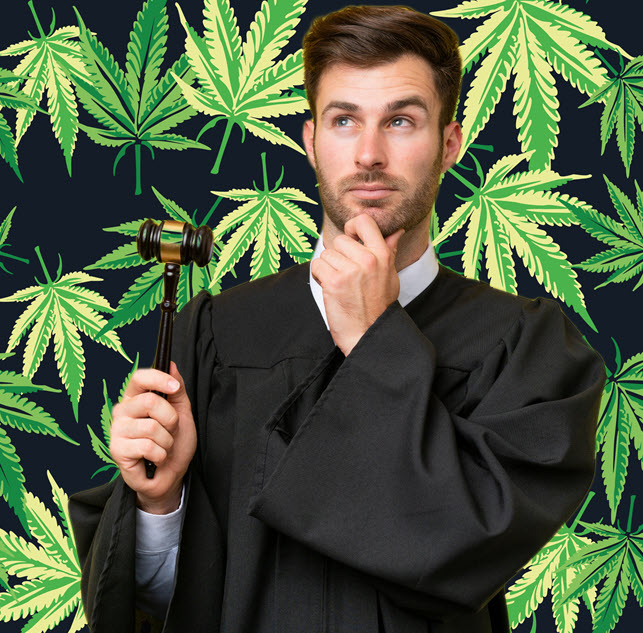Cannabis News
Win Free Weed for a Year
Published
7 months agoon
By
admin

It was only a matter of time before something like this happened. West Coast Cure (WCC) has come up with a cool contest inspired by the famous Willie Wonka event but with a twist. Instead of chocolate, they’re offering weed! Up to five lucky winners could get a year’s supply of top-quality cannabis for just $4.20. That’s a steal for any weed lover out there.
Jonathan Jones, who’s in charge of marketing at WCC, is super excited about this. He says they’re thrilled to be connecting with California’s weed community in such a fun way. Jones thinks this contest isn’t just about winning. It’s a chance for people to show off their love for weed in all sorts of creative ways. So whether you’re a big-time fan or just enjoy weed casually, this contest is for you.
Jones also wants everyone to know that WCC is all about celebrating the weed culture. They’re not just in it for the money but genuinely care about the people who love their products. So, if you’re in California and love weed, this contest might just be your golden ticket to a year of blissful highs.
A Dual Approach
West Coast Cure (WCC) is launching two exciting contests exclusively for California residents. These contests will run from March 29 to April 20, 2024, for the UGC campaign and on June 1, 2024, for the Diamond Tickets campaign. The aim is to blend creativity and skill in celebrating California’s vibrant cannabis culture.
These contests are designed to showcase and promote WCC’s Jefferey Minis, infused joints containing premium flowers, THCa diamonds, and top-shelf kief. Participants have two ways to enter and become eligible to win.
First, they can hunt for one of the four secret Diamond Tickets hidden within the Jefferey 5-pack minis available at select retailers. Alternatively, they can unleash their creativity by participating in the #WCCDIAMONDS UGC (User-Generated Content) contest.
This dual approach not only engages participants in a fun and interactive manner but also highlights the uniqueness of WCC’s products. By combining elements of exploration and creativity, WCC aims to connect with California’s diverse cannabis community and celebrate the state’s essence of cannabis culture.
So, whether you’re on the hunt for hidden tickets or eager to showcase your creativity, these contests offer something for everyone to enjoy.
If you are one of the lucky ones to uncover a Diamond Ticket, you’ll have the chance to participate in a trivia contest to confirm your win. For those entering the UGC contest, get ready to showcase your creative flair by crafting the most captivating photo or video featuring a gutted Jefferey. The winner, handpicked by WCC co-founder JCURES, will be selected based on the originality of their submission.
These contests shine a spotlight on the Jefferey Minis, underscoring West Coast Cure’s unwavering commitment to top-notch quality. These infused joints, boasting premium flowers, THCa diamonds, and top-shelf kief, exemplify WCC’s dedication to pushing boundaries regarding excellence and innovation within the cannabis industry.
A Wide Range of Cannabis Strain
With 15 strains available in the Jefferey 5-pack Minis, participants have the opportunity to delve into a spectrum of experiences tailored to their unique preferences. This lineup features renowned strains such as Blackberry Kush, Jack Herer, and OG Kush, alongside a delightful selection including Blueberry Haze, Pink Lemonade, and Frozen Cherries.
For those craving something distinct, options like Gelato, Maui Waui, and Blue Dream offer a unique twist, while dessert-inspired varieties such as Strawberry Cream, Cereal Milk, Strawberry Shortcake, and Watermelon Zkittlez add a flavorful touch.
This diverse range ensures that every cannabis enthusiast, whether in search of relaxation, rejuvenation, or a surge of creativity, can discover their ideal match within the Jefferey 5-pack Minis collection. Participants and budtenders alike are encouraged to enter the contests, fostering a sense of communal enthusiasm for California’s exceptional cannabis offerings.
As individuals explore the various strains and engage with the contests, they contribute to the vibrant cannabis culture while celebrating the excellence and diversity that characterize the state’s cannabis scene.
In essence, West Coast Cure’s inventive contest promising a year’s supply of premium cannabis stands as a testament to their commitment to the cannabis community. This offering attracts fans’ attention and emphasizes WCC’s desire to supply premium products. By providing winners with a year’s worth of cannabis, WCC not only fosters joy but also ensures sustained enjoyment and appreciation of their diverse strains.
This program not only demonstrates their generosity but also shows the strength of belonging, which deepens the bond between WCC and its customers and reminds them of a brand that cares about the well-being and satisfaction of the wider cannabis community.
About West Coast Cure
The West Coast Cure is a renowned and credible brand among the most prominent and celebrated cannabis products from the Golden State. Their mission is simple yet profound: to produce cannabis products that are of an exceptionally high standard and are therefore unique in the market, while at the same time making these products affordable to purchase.
For many years now, consumers have continued to rely on West Coast Cure, thanks to their unquestionable integrity behind quality and consistency.
The pinnacle of their success is almost a decade’s worth of experience in fine-tuning cutting-edge strains. To this effect, they take pride in their unwavering commitment to quality, which has seen them establish strong partnerships with renowned cultivators.
Their collaborations with cutting-edge wax artists have been instrumental in reinforcing the perception that they always strive for excellence in cannabis production. It’s no wonder West Coast Cure is renowned in the industry for its high-quality, top-tier flowers, potent concentrates, and expertly crafted edibles. Their products are sold at your local dispensary or can be delivered to you anywhere in California.
Join the bandwagon in experiencing the difference that quality, passion, and expertise can make in your cannabis journey with West Coast Cure.
MORE CANNABIS DREAM JOBS, READ ON…
$70,420 TO SMOKE WEED AND POST ABOUT IT, WOULD YOU APPLY FOR THIS JOB?
You may like
-


Make Autumn Awesome With The Best Oreo Cookie Hacks
-


Can An Air Purifier Get Rid Of The Marijuana Smell
-


Maternal Cannabis Use Does Not Lead to Higher Rates of ADHD or Behavior Disorders in Children Says New Massive Medical Study
-


The Court Case That Could Legalize Marijuana in America
-


Leafly Buzz: 12 top weed strains of October
-


Permanent Marker—MOCA, California, fall 2024
Cannabis News
Maternal Cannabis Use Does Not Lead to Higher Rates of ADHD or Behavior Disorders in Children Says New Massive Medical Study
Published
12 hours agoon
October 23, 2024By
admin

Let’s get one thing straight right off the bat: it’s generally best for expecting mothers to avoid consuming any substances during pregnancy. That’s just common sense. But as someone who’s watched his wife go through the miraculous and downright brutal process of pregnancy twice, I can tell you firsthand – growing a human ain’t no walk in the park.
Pregnancy is hardcore, period. You’re bloated, in pain, and your organs are literally rearranging themselves to make room for a tiny squatter. And don’t even get me started on morning sickness. For some women, it’s more like all-day, soul-crushing nausea that makes you wonder why our species hasn’t gone extinct yet.
It’s no wonder that for centuries, cannabis has been viewed as a natural remedy for these pregnancy woes. Our ancestors knew a thing or two about plant medicine, after all. But in recent decades, we’ve been bombarded with warnings that maternal cannabis use increases the risk of behavior disorders and ADHD in children. Scary stuff for any parent-to-be, right?
Well, hold onto your bongs, folks, because a new study is challenging that narrative. This isn’t some small-scale research either – we’re talking about a massive study involving over 100,000 participants. And guess what? They found no link between maternal cannabis use and an increased risk of ADHD or behavior disorders in offspring.
Now, before you start planning a pregnancy hotbox party, let’s take a deeper look at this study and what it really means. We’ll also compare the risk profiles of cannabis to some of the currently accepted medications for morning sickness. Because let’s face it, those pharma-approved pills aren’t exactly risk-free either.
So strap in, dear readers. We’re about to embark on a journey through the complex world of pregnancy, cannabis, and the ever-evolving landscape of medical research. It’s time to separate fact from fiction and give expectant mothers the information they need to make informed decisions about their health and the health of their future little ones.
First off, let’s talk scope. This isn’t some rinky-dink study done in a college dorm room (though those can be fun too). We’re looking at a behemoth of a research project that makes most studies look like a kiddie pool next to the Pacific Ocean.
The researchers, a team of brainiacs from Kaiser Permanente Northern California, the University of California, and The Permanente Medical Group, analyzed data from a whopping 141,570 children born to 117,130 pregnant individuals. That’s more people than the entire population of Topeka, Kansas, folks. The study covered births from 2011 to 2018, giving us a solid chunk of time to work with.
Now, here’s where it gets interesting. Of these 117,130 pregnant individuals, 4.6% screened positive for cannabis use during early pregnancy. That’s about 5,388 cannabis-using moms-to-be, if my back-of-the-rolling-paper math is correct.
So, what did they find? Hold onto your hats, because this might blow your mind: maternal prenatal cannabis use was not associated with an increased risk of offspring developing ADHD or disruptive behavior disorders (DBD). In fact, the adjusted hazard ratio for ADHD was 0.84, which is science-speak for “Nope, no link here.”
But wait, it gets even more intriguing. When it came to DBD, they actually found an inverse association. The adjusted hazard ratio was 0.83, suggesting that children of cannabis-using mothers were slightly less likely to develop disruptive behavior disorders. Now, before you start recommending pot for pregnant ladies, remember that correlation doesn’t equal causation. But it’s certainly food for thought.
Let’s hear it straight from the horse’s mouth. The study concludes, and I quote, “Maternal prenatal cannabis use was not associated with an increased risk of offspring ADHD or DBD.” That’s about as clear as it gets, folks.
Now, why is this important? Well, for starters, it challenges the long-held belief that cannabis use during pregnancy is a one-way ticket to behavioral issues for the kid. This study, with its massive sample size and rigorous methodology, provides some serious scientific firepower to counter those claims.
But here’s the kicker: the researchers aren’t saying “Go ahead and blaze it, preggo!” They’re quick to point out that while these findings are significant, they don’t suggest that marijuana use during pregnancy is risk-free. There’s still a lot we don’t know about the long-term effects of prenatal cannabis exposure.
What this study does do is open the door for more nuanced, evidence-based discussions about cannabis use during pregnancy. It gives us a solid foundation to question some of the fear-mongering that’s been going on and to push for more research in this area.
In the world of science, a study like this is like dropping a boulder in a pond. The ripples are going to be felt for a long time, potentially influencing everything from public health policies to individual decisions made by expectant mothers.
Now, I’m not here to bash Big Pharma (well, maybe a little), but let’s take a look at some of the common medications prescribed for morning sickness. It’s like a chemical alphabet soup, and the side effects? Well, they might just make you want to puke.
First up, we’ve got Doxylamine. Sounds fancy, right? It’s an antihistamine that’s often combined with vitamin B6 to combat nausea. But here’s the kicker: it can cause drowsiness, dizziness, and even movement disorders. Because that’s exactly what a pregnant woman needs – to feel like she’s stumbling around in a fog.
Then there’s Metoclopramide, a “promotility agent” that sounds like something you’d use to clean your toilet. It stimulates stomach and bowel movement, which is great if you want to spend even more time in the bathroom. Side effects? Oh, just little things like depression, anxiety, and tardive dyskinesia – a fun little condition that causes uncontrollable movements. Lovely.
For the overachievers in morning sickness, we’ve got Ondansetron. It’s often prescribed for hyperemesis gravidarum, which is fancy doctor-speak for “holy crap, I can’t stop puking.” But watch out for those pesky side effects like headaches, constipation, and oh yeah, potential heart rhythm problems.
Now, let’s talk about Mirtazapine. It’s an antidepressant that they pull out when nothing else works. Because apparently, the solution to not being able to keep food down is to take a drug that can cause increased appetite and weight gain. Makes perfect sense, right?
And for the grand finale, we’ve got Corticosteroids. These bad boys are reserved for severe cases, probably because their potential side effects read like a medical textbook’s index. We’re talking increased risk of gestational diabetes, preeclampsia, and low birth weight. But hey, at least you’re not nauseous anymore!
Now, here’s where things get interesting. The LD-50 (that’s the dose that’s lethal for 50% of test subjects) for these drugs ranges from about 500mg/kg to 1000mg/kg in rats. For cannabis? It’s estimated to be around 1260mg/kg when orally ingested. That’s higher than any of these pharmaceutical options.
So, let me get this straight. We’re okay with giving pregnant women drugs that can cause everything from movement disorders to depression to potential heart problems, but a plant that’s been used for centuries to combat nausea is off-limits? A plant that, I might add, has a higher LD-50 than these lab-created concoctions?
Look, I’m not saying cannabis is risk-free during pregnancy. We need more research, and every woman should make an informed decision with her doctor. But when I see the list of side effects for these “approved” medications, I can’t help but wonder: are we really making decisions based on health and safety, or are we stuck in a prohibition-era mindset?
It’s time we start asking some hard questions about our approach to morning sickness treatment. Why are we so quick to reach for the prescription pad when Mother Nature might have a gentler solution? Why is it okay to give pregnant women drugs with laundry lists of side effects, but not one that grows out of the ground?
I don’t have all the answers, folks. But I do know this: when it comes to pregnancy and cannabis, we need to cut through the fear-mongering and look at the facts. Because at the end of the day, what matters most is the health and well-being of mom and baby. And sometimes, the best medicine might just be the one that’s been growing in our backyards all along.
Source:
https://themarijuanaherald.com/2024/10/study-of-over-100000-finds-
maternal-marijuana-use-not-associated-with-increased-risk-of-adhd-or-behavior-disorders-in-children/
https://pubmed.ncbi.nlm.nih.gov/39400201/
PREGNANT AND CANNABIS, READ ON..
Cannabis News
The Court Case That Could Legalize Marijuana in America
Published
13 hours agoon
October 23, 2024By
admin

In a pivotal legal battle that could reshape the future of cannabis regulation in the United States, the U.S. Department of Justice (DOJ) has reiterated its commitment to enforcing federal cannabis prohibition. This assertion was made during a recent appeal in the First Circuit Court, where cannabis companies, including Canna Provisions, are challenging the federal government’s authority under the Controlled Substances Act (CSA). As states increasingly legalize marijuana for both medical and recreational use, this case underscores the ongoing conflict between state and federal laws regarding cannabis.
The Legal Landscape of Cannabis
Understanding the Controlled Substances Act
The Controlled Substances Act, enacted in 1970, categorizes drugs into five schedules based on their potential for abuse and accepted medical use. Cannabis is classified as a Schedule I substance, which implies it has a high potential for abuse and no accepted medical use in treatment in the United States. This classification has long served as the foundation for federal drug policy, creating a complex legal environment for states that have opted to legalize cannabis.
The Rise of State-Level Legalization
The movement toward cannabis legalization began gaining traction in the late 1990s with California’s Proposition 215, which allowed medical use of marijuana. Since then, numerous states have followed suit, with many also legalizing recreational use. As of October 2024, 23 states and Washington D.C. have legalized recreational cannabis, while 38 states allow some form of medical use.
This rapid shift at the state level has resulted in a patchwork of laws across the country. Advocates argue that legalization can lead to increased tax revenue, reduced criminal justice costs, and improved public health outcomes. However, opponents caution against potential public health risks and societal issues stemming from increased access to cannabis.
The Current Case: Canna Provisions vs. DOJ
Canna Provisions, along with several other cannabis companies, has filed an appeal challenging the federal government’s enforcement of the CSA against their operations. They argue that the changing landscape of state laws should compel a reevaluation of federal prohibition. The appeal emphasizes that state-level legalization reflects a growing acceptance of cannabis use and should be respected by federal authorities.
The DOJ countered this argument by asserting that Congress retains the authority to regulate substances under the CSA, regardless of state laws. They argue that allowing states to dictate their own cannabis policies undermines federal law and could lead to chaos in drug enforcement.
Key Arguments from Both Sides
Canna Provisions and Supporters
1. State Sovereignty: Proponents argue that states should have the autonomy to regulate cannabis as they see fit, particularly given the evolving public perception surrounding its safety and efficacy.
2. Economic Benefits: The cannabis industry has generated billions in tax revenue for states that have legalized it. Advocates argue that continued federal prohibition hampers economic growth and job creation.
3. Public Health Considerations: Supporters contend that regulated markets can better ensure product safety than illegal markets, thereby protecting consumers.
4. Changing Social Norms: Public opinion has shifted dramatically over recent years; polls show that a significant majority of Americans now support legalization.
U.S. Department of Justice
1. Federal Authority: The DOJ maintains that Congress has explicitly prohibited cannabis under the CSA and that this law must be upheld uniformly across all states.
2. Precedent: The DOJ cites the 2005 Supreme Court case Gonzales v. Raich as a key precedent affirming federal authority over state laws concerning controlled substances.
3. Public Safety Concerns: The DOJ argues that cannabis poses health risks and societal issues that warrant continued prohibition at the federal level until further research can definitively address these concerns.
4. Potential for Abuse: The government warns that loosening restrictions could lead to increased drug abuse and related criminal activity.
Implications of the Appeal
For Cannabis Companies
The outcome of this appeal could set a precedent for how cannabis businesses operate within an increasingly complicated legal framework. If Canna Provisions succeeds in its appeal, it could pave the way for more lenient enforcement of federal cannabis laws or even encourage Congress to reconsider its stance on marijuana.
Conversely, if the DOJ prevails, it would reinforce existing prohibitions and potentially stifle growth within an industry that has already seen significant investment and expansion over recent years.
For State Governments
A ruling favoring Canna Provisions could embolden other states considering legalization or expansion of their current laws. It would signal to lawmakers that they can operate independently from federal mandates without fear of repercussions.
On the other hand, if the DOJ wins, it could deter state governments from pursuing further legalization efforts due to fears of federal intervention or penalties.
For Federal Policy
This case represents a critical juncture in U.S. drug policy. A ruling in favor of either side could influence future legislative discussions around cannabis reform at the federal level.
Should Canna Provisions win its case, it may prompt Congress to reconsider its approach to marijuana regulation altogether—potentially leading to decriminalization or rescheduling under the CSA.
Public Opinion on Cannabis Legalization
Public sentiment regarding cannabis has shifted dramatically over recent decades. According to recent polls:
-
Approximately 68% of Americans support legalizing marijuana.
-
Support is particularly strong among younger demographics but has also grown among older age groups.
-
Many Americans view legalization as an issue of personal freedom and economic opportunity rather than a public health crisis.
This shift in public opinion is crucial as lawmakers consider their positions on cannabis legislation both at the state and federal levels.
Social Justice and Economic Equity
Social Justice Considerations
The debate over cannabis legalization is not solely about economics; it also encompasses social justice issues. Many advocates argue that communities disproportionately affected by past drug policies deserve reparative measures through legalization efforts. These measures may include expunging criminal records related to non-violent cannabis offenses and ensuring equitable access to business opportunities within the burgeoning industry.
Economic Equity
Legalization provides an opportunity to create jobs and stimulate local economies; however, disparities exist within who benefits from these opportunities. Ensuring equity means addressing barriers faced by marginalized communities seeking to enter the legal market such as high startup costs or regulatory hurdles.
Conclusion
As oral arguments approach in the pivotal case involving Canna Provisions and the DOJ, the outcome could significantly impact individual freedoms and economic opportunities, extending beyond a single company or court ruling. This ongoing conflict between state-level legalization and federal prohibition highlights a broader debate about personal liberty, public health, economic strategy, and social justice in America. As public perceptions of cannabis continue to evolve, this case may serve as a crucial litmus test for future drug policy reforms nationwide. The eventual ruling will likely resonate far beyond the courtroom, influencing discussions about cannabis in homes across America.
THE SUPREME COURT TO DECIDE MARIJUANA FATE? READ ON…
Cannabis News
40% of Cancer Patients are Now Using Cannabis to Manage Symptoms?
Published
2 days agoon
October 22, 2024By
admin

The landscape of cancer treatment is continually evolving, with patients exploring various avenues for symptom relief and enhanced quality of life. Among these avenues, cannabis has emerged as a significant player, particularly for cancer patients seeking relief from pain, nausea, and other debilitating symptoms associated with their condition and its treatment. As the use of cannabis grows in this demographic, the National Cancer Institute (NCI) has underscored the pressing need for the rescheduling of cannabis at the federal level. This article delves into the reasons behind this call for rescheduling, the implications of current regulations, and the potential benefits that could arise from a change in cannabis classification.
Understanding Cannabis and Its Therapeutic Potential
Cannabis sativa, commonly known as marijuana, contains numerous compounds known as cannabinoids, the most well-known being tetrahydrocannabinol (THC) and cannabidiol (CBD). THC is primarily responsible for the psychoactive effects associated with cannabis use, while CBD is non-psychoactive and has garnered attention for its potential therapeutic properties.
Therapeutic Benefits for Cancer Patients
Research has indicated that cannabis can offer several benefits to cancer patients:
1. Pain Relief: Cancer-related pain can be severe and persistent. Studies have shown that cannabinoids can help alleviate this pain by interacting with the body’s endocannabinoid system.
2. Nausea and Vomiting: Chemotherapy often induces severe nausea and vomiting. Cannabis has been found to be effective in reducing these symptoms, providing patients with much-needed relief.
3. Appetite Stimulation: Many cancer patients experience loss of appetite due to their illness or treatment side effects. THC has been shown to stimulate appetite, helping patients maintain their nutritional intake.
4. Anxiety and Depression Relief: The psychological toll of a cancer diagnosis can be overwhelming. Some studies suggest that cannabis may help alleviate symptoms of anxiety and depression in patients.
5. Sleep Aid: Insomnia is common among cancer patients due to pain, anxiety, or other factors. Cannabis may assist in improving sleep quality.
Growing Acceptance Among Patients
As awareness of these benefits spreads, an increasing number of cancer patients are turning to cannabis as a complementary therapy. Surveys indicate that approximately 20-40% of cancer patients use cannabis to manage their symptoms. This trend reflects a growing acceptance of cannabis within both patient communities and some segments of the medical community.
Current Legal Status of Cannabis
Cannabis is currently classified as a Schedule I substance under the Controlled Substances Act (CSA) in the United States. This classification denotes that it is considered to have a high potential for abuse, no accepted medical use, and a lack of accepted safety for use under medical supervision.
Implications of Schedule I Status
The Schedule I status has profound implications:
The Call for Rescheduling
The NCI’s recent emphasis on the need for rescheduling cannabis stems from an acknowledgment of its growing use among cancer patients and the necessity for more comprehensive research. By rescheduling cannabis to at least Schedule III where substances are recognized as having accepted medical uses but still require regulation several beneficial changes could occur:
1. Enhanced Research Opportunities: Rescheduling would facilitate more rigorous scientific studies into the efficacy and safety of cannabis for various medical conditions, including cancer.
2. Improved Education for Healthcare Providers: With rescheduling, medical schools and continuing education programs could incorporate more information about cannabis, equipping healthcare providers to better advise their patients.
3. Increased Patient Safety: A clearer regulatory framework would help clarify dosing guidelines, potential drug interactions (especially with treatments like chemotherapy), and overall patient safety considerations.
4. Insurance Coverage: Rescheduling could pave the way for insurance companies to cover medical cannabis expenses, making it more accessible for patients who need it.
Legislative Landscape
While there have been efforts at both state and federal levels to reform cannabis laws, progress remains slow. The 2018 Farm Bill legalized hemp-derived CBD products but did not address broader issues related to marijuana’s classification. Various bills have been introduced in Congress aimed at rescheduling or decriminalizing cannabis; however, none have yet gained sufficient traction for passage.
The Need for Comprehensive Research
The existing body of research on cannabis is limited by several factors:
-
Insufficient Funding: Due to its Schedule I status, obtaining funding for cannabis research can be challenging.
-
Lack of Standardization: Variability in strains, dosages, and methods of administration complicates research efforts.
-
Limited Longitudinal Studies: Most studies are short-term and do not provide insights into long-term effects or efficacy over time.
Areas Requiring Further Investigation
To fully understand the potential benefits and risks associated with cannabis use among cancer patients, further research is needed in several key areas:
1. Efficacy Studies: Large-scale clinical trials are essential to determine how effective cannabis is in alleviating specific symptoms related to cancer treatment.
2. Safety Profiles: Research must explore potential side effects and interactions between cannabinoids and conventional cancer therapies.
3. Optimal Delivery Methods: Investigating different methods of administration (e.g., smoking vs. edibles vs. oils) will help identify which methods are most effective for symptom relief.
4. Long-term Effects: Understanding how long-term use impacts overall health outcomes in cancer survivors is crucial.
Patient Perspectives on Cannabis Use
To gain a deeper understanding of how cancer patients perceive cannabis use, qualitative studies involving interviews or focus groups can provide valuable insights:
-
Personal Experiences: Many patients report significant improvements in quality of life when using cannabis alongside traditional treatments.
-
Barriers to Access: Patients often face challenges related to legality, stigma, and lack of guidance from healthcare providers regarding safe usage.
-
Desire for Information: There is a clear demand among patients for more information about how to use cannabis effectively and safely during their treatment journey.
Case Studies
Numerous anecdotal accounts highlight the transformative impact that cannabis can have on individual patients’ lives:
These stories underscore the importance of understanding patient needs and experiences when considering policy changes related to cannabis use in healthcare settings.
Ethical Considerations Surrounding Cannabis Use
Informed Consent
As with any treatment option, informed consent is crucial when discussing cannabis use with cancer patients:
-
Patients must be educated about potential benefits and risks.
-
Clear communication regarding dosing guidelines and possible interactions with other medications should be prioritized.
Equity in Access
Rescheduling could also address issues related to equity in access:
-
Disparities exist among different demographics regarding access to medical marijuana.
-
Ensuring equitable access will require thoughtful policy changes that consider socioeconomic factors affecting patient populations.
Conclusion
As the conversation surrounding cannabis use among cancer patients continues to evolve, it becomes increasingly clear that rescheduling this substance is vital for advancing research, improving patient care, and enhancing overall safety in its use as a therapeutic option. The NCI’s call for rescheduling reflects a growing recognition within the medical community that we must adapt our policies to align with emerging evidence regarding the benefits of cannabis in managing symptoms associated with cancer treatments. Moving forward requires collaboration between researchers, healthcare providers, policymakers, and patient advocates to create an environment where comprehensive research can flourish, ultimately leading to informed decisions that empower cancer patients on their journey toward healing and recovery. As we navigate this complex landscape together, we must prioritize patient safety while embracing innovative approaches that may enhance quality of life during one of life’s most challenging experiences.
DOES CANNABIS PREVENT PROSTATE CANCER, READ ON..

Make Autumn Awesome With The Best Oreo Cookie Hacks

Can An Air Purifier Get Rid Of The Marijuana Smell

Maternal Cannabis Use Does Not Lead to Higher Rates of ADHD or Behavior Disorders in Children Says New Massive Medical Study

The Court Case That Could Legalize Marijuana in America

Leafly Buzz: 12 top weed strains of October

Permanent Marker—MOCA, California, fall 2024

Red States Lean Green This Election

The 12 best Gelato crosses of all time

Can Cannabis Or Alcohol Help With Colds

40% of Cancer Patients are Now Using Cannabis to Manage Symptoms?

Distressed Cannabis Business Takeaways – Canna Law Blog™

United States: Alex Malyshev And Melinda Fellner Discuss The Intersection Of Tax And Cannabis In New Video Series – Part VI: Licensing (Video)

What you Need to Know

Drug Testing for Marijuana – The Joint Blog

NCIA Write About Their Equity Scholarship Program

It has been a wild news week – here’s how CBD and weed can help you relax

Cannabis, alcohol firm SNDL loses CA$372.4 million in 2022

A new April 20 cannabis contest includes a $40,000 purse

Your Go-To Source for Cannabis Logos and Designs

UArizona launches online cannabis compliance online course
Trending
-

 Cannabis News2 years ago
Cannabis News2 years agoDistressed Cannabis Business Takeaways – Canna Law Blog™
-

 One-Hit Wonders2 years ago
One-Hit Wonders2 years agoUnited States: Alex Malyshev And Melinda Fellner Discuss The Intersection Of Tax And Cannabis In New Video Series – Part VI: Licensing (Video)
-

 Cannabis 1012 years ago
Cannabis 1012 years agoWhat you Need to Know
-

 drug testing10 months ago
drug testing10 months agoDrug Testing for Marijuana – The Joint Blog
-

 Education2 years ago
Education2 years agoNCIA Write About Their Equity Scholarship Program
-

 Cannabis2 years ago
Cannabis2 years agoIt has been a wild news week – here’s how CBD and weed can help you relax
-

 Marijuana Business Daily2 years ago
Marijuana Business Daily2 years agoCannabis, alcohol firm SNDL loses CA$372.4 million in 2022
-

 California2 years ago
California2 years agoA new April 20 cannabis contest includes a $40,000 purse







